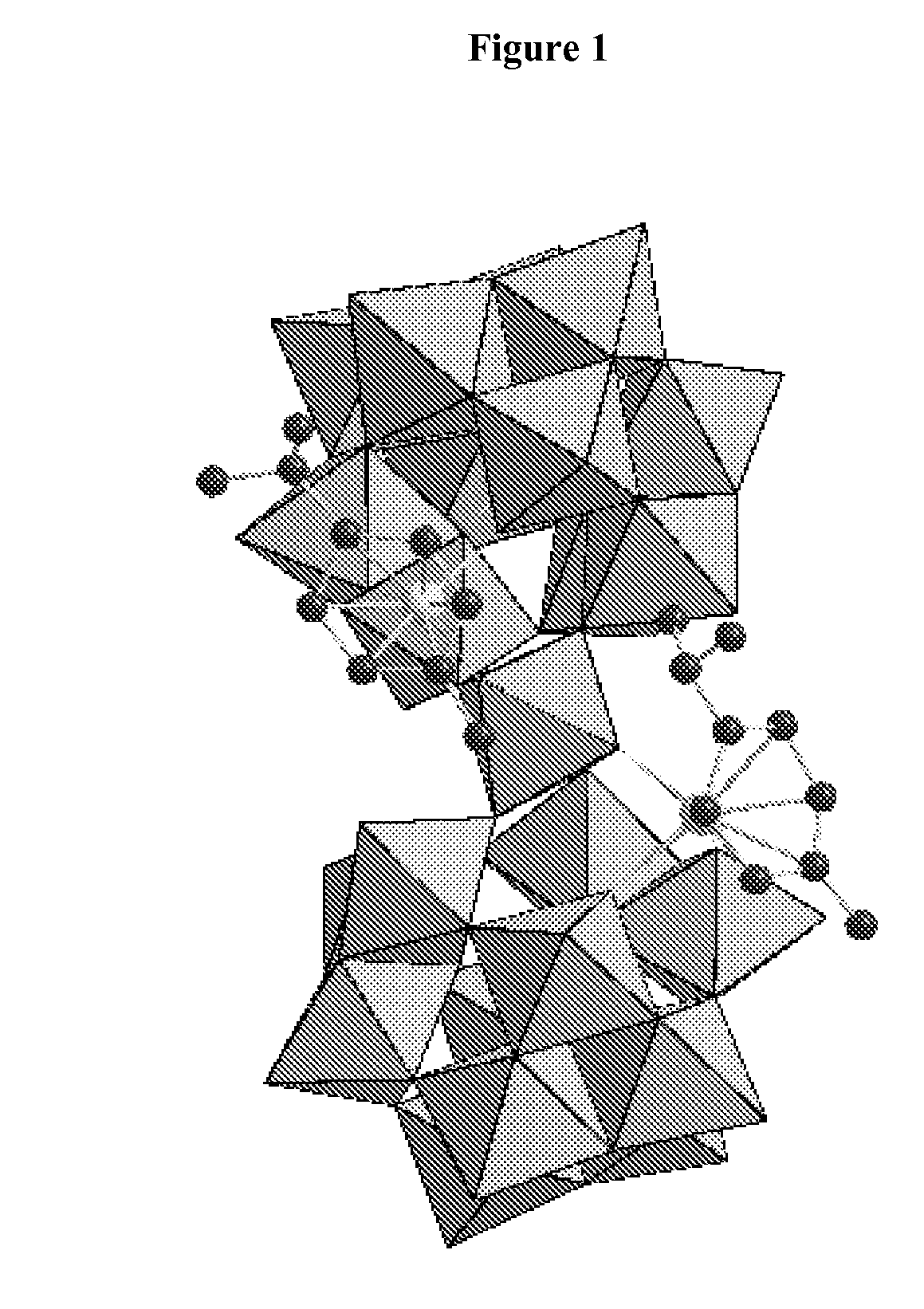Novel Ru-Containing Polyoxotungstates and Process for Their Preparation
a technology of polyoxotungstates and polyoxometalates, which is applied in the direction of organic compounds/hydrides/coordination complexes, physical/chemical process catalysts, organic compounds/chemical process catalysts, etc., can solve the problems of difficult isolation and low yield of ru-containing anions, and achieve easy and reproducible preparation, high yield and purity
- Summary
- Abstract
- Description
- Claims
- Application Information
AI Technical Summary
Problems solved by technology
Method used
Image
Examples
example 1
Synthesis of K10[Ru2(benzene)2(α-GeW11O39)2WO 2].10H2O using [β2GeW11O39]8−
[0113]The samples of [(C6H6)2RuCl2]2 (0.09 g; 0.18 mmol) and K8[β2-GeW11O39] 14H2O (1.18 g; 0.36 mmol) (synthesized according to Nsouli et al., Inorg. Chem., 2006, 45, 3858) were dissolved with stirring and heating to 80° C. for 10 min in 15 mL of water. By adding a few drops of 1M HCl the pH was adjusted to 3.9. The reaction mixture was heated to 80° C. for 20 min, with the final pH being 5.0. A small amount of an orange precipitate was filtered off. Then, 2 mL of 1.0 M KCl solution was added to the solution. Slow evaporation at room temperature led to a dark brown crystalline product in one week which was recrystallized from hot water (yield 0.70 g, 60%).
[0114]IR (cm−1): 952(s), 882(s), 820(s), 792(sh), 757(sh), 690(s), 619(sh), 527(m), 468(m) (measured on a Nicolet-Avatar 370 spectrometer using KBr pellets).
[0115]Besides IR, the product was also characterized by single-crystal XRD. The crystal data and str...
example 2
Synthesis of K10Ru2(p-cymene)2(α-GeW11O39)2WO2].28H2O using [β2-GeW11O39]8−
[0116][(p-cymene)2RuCl2]2 (0.110 g; 0.18 mmol) and K8[β2-GeW11O39] 14H2O (1.18 g; 0.36 mmol) (synthesized according to Nsouli et al., Inorg. Chem., 2006, 45, 3858) were dissolved with stirring and heating to 80° C. for 15 min in 15 mL of water. The initial pH was 5.0. By adding few drops of 1M HCl the pH was adjusted to 4.0. The reaction mixture was heated to 80° C. for 15 min, with the final pH being 4.5. A small amount of a dark precipitate was filtered off. Then, 2 mL of 1.0 M KCl solution was added to the orange solution. Slow evaporation at room temperature led to a dark orange crystalline product in the form of plates and needles) in one week (yield 0.582 g, 50%).
[0117]IR (cm−1): 952(s), 886(s), 821(s), 791(sh), 758(s), 719(sh), 687(s), 527(m), 483(sh), 469(m) (measured on a Nicolet-Avatar 370 spectrometer using KBr pellets).
TABLE 2Crystal data and structure refinement obtained on a Bruker KappaAPEX II ...
example 3
Synthesis of K10[Ru2(benzene)2(α-GeW11O39)2WO2].10H2O using [α-GeW11O39]8−
[0118][(C6H6)2RuCl2]2 (0.09 g; 0.18 mmol) and K6Na2[α-GeW11O39] 13H2O (1.164 g; 0.36 mmol) (synthesized according to Tézé et al., J. Inorg. Nucl. Chem., 1977, 39, 999, followed by purification via recrystallization from hot water) were dissolved with stirring and heating to 80° C. for 10 min in 15 mL of water. The initial pH was 4.7. By adding few drops of 1M HCl the pH was adjusted to 4.0. The reaction mixture was heated to 80° C. for 20 min, with the final pH being 4.3. A small amount of an orange precipitate was filtered off. Then, 2 mL of 1.0 M KCl solution were added to the orange solution. Slow evaporation at room temperature led to an inseparable crystalline mixture of the desired title compound (dark red plates) as well as unwanted side-products (light orange blocks and orange needles) in one week. Recrystallization from hot water still resulted in a mixture of compounds.
PUM
| Property | Measurement | Unit |
|---|---|---|
| temperature | aaaaa | aaaaa |
| temperature | aaaaa | aaaaa |
| temperature | aaaaa | aaaaa |
Abstract
Description
Claims
Application Information
 Login to View More
Login to View More - R&D
- Intellectual Property
- Life Sciences
- Materials
- Tech Scout
- Unparalleled Data Quality
- Higher Quality Content
- 60% Fewer Hallucinations
Browse by: Latest US Patents, China's latest patents, Technical Efficacy Thesaurus, Application Domain, Technology Topic, Popular Technical Reports.
© 2025 PatSnap. All rights reserved.Legal|Privacy policy|Modern Slavery Act Transparency Statement|Sitemap|About US| Contact US: help@patsnap.com


